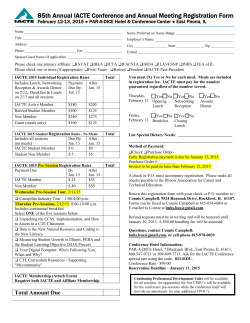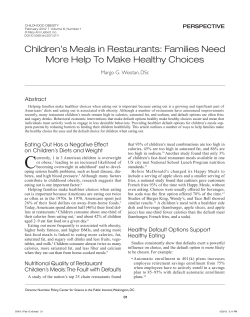
A
nutrition Transforming the male gut Paul Collins, BPE Paul is director of www.thebodycoach.com and personal trainer to Olympic and Paralympic world champions. He is author of eight books including best-sellers The Body Coach: Firmer Thighs & Trimmer Waist for women, How to Lose Your Love Handles, 3 Hour Rule® Weight Loss Program for Men, and The Body Coach: Core-strength Basics. Paul’s upcoming titles include Belly Busters® for Men,Thigh Busters® for women and the Fastfeet® - Speed for Sport program. A s trainers we all know how to lose weight - eat less fat and fewer calories, and exercise and move more often. But our real challenge lies in how we put this into practice with our clients. Lose the love handles The primary concern of being overweight should be one of health and not appearance. We know that high blood pressure is twice as common in obese adults and that obesity can also affect the quality of life through limited mobility and decreased physical endurance. Obese men (with a body mass index (BMI) of more than 30) have a 50 to 100 per cent increased risk of dying younger than their peers who maintain a healthy weight (Healthy BMI for men = 20 - 25). To calculate BMI, use the formula weight (kg)/height 2 . For example, if you are 180 cm tall and weigh 105kg, your BMI is 105/1.8x1.8 = 105/3.24; BMI = 32.4. Even if your clients are only a few kilograms overweight, they have an increased risk of developing arthritis or heart disease, which can potentially result in a heart attack, congestive heart failure, sudden cardiac death, angina or chest pain, or an abnormal heart rhythm. Between the ages of 30 and 50, the average man gains around 500 grams of fat per year. That doesn’t sound like much over 12 months, but when this is combined with an average muscle loss of around 5 kilos per decade, it adds up. Reducing your clients’ bodyweight by as little as 5 to 10 per cent, or their waistline below 90cm, significantly reduces the risk factors for some diseases, particularly heart disease. It can also lower their blood pressure, improve their blood sugar, cholesterol and energy levels. The 3 Hour Rule® - A major breakthrough in trimming the waistline 64 • Network • autumn 2006 Nutritionists have known for some time that eating smaller meals more frequently, can actually help lose weight. The 3 Hour Rule® concept is actually incredibly simple - rather than eating three larger main meals each day, your clients simply eat five smaller meals at three hour intervals (ideally within a range of 2.5 to 3.5 hours of each other). This strategy provides the body with the best possible chance to digest food. By controlling the content and portion size of meals, as well as developing a positive eating routine, your clients will dramatically improve their likelihood of losing weight. Getting to know a man’s eating patterns Some men will quite happily go through the day with nothing more than coffee and biscuits and then eat non-stop as soon as they get home. Others eat anything and everything that’s put in front of them, regardless of how much there is smorgasbords are real danger zones for these guys! Others will skip breakfast or graze continually throughout the day. Whatever the case, I find most men fall into one of five eating categories: 1. Skipper Skipping meals is not good for anyone, as the body needs refuelling regularly in order to maintain a constant energy level. Skipping breakfast and then playing ‘catch up’ throughout the rest of the day puts undue stress on the digestive system by causing the body to lower its metabolic rate. 2. Delayer The Delayer may think he’s controlling his weight and limiting his food intake by leaving such long gaps between meals, but he’s not. Leaving up to six hours between meals during the day causes the Delayer’s blood sugar levels to drop to crisis point. This causes a corresponding fall in his energy nutrition levels and he craves something sweet to give him an energy boost. 3. Overeater If you skip meals, or leave too long a gap between meals, you are more likely to eat too much when you finally sit down to a meal. If you eat more than your body needs, you will overload your digestive system which will make you feel bloated and lethargic. It will also make you gain weight. Overeating is the most common cause of weight gain in a healthy system, even if you exercise regularly and eat all the right foods. 4. Unwinder Our increased reliance on digital technology has seen a new Unwinder emerge. The twenty-first century Unwinder tends to bring the stress of his working day home with him, along with his laptop, and use alcohol or refined sugar products such as biscuits, chips, ice-cream and chocolate to help him drop down a couple of gears at the end of his day. 5. Bloater The Bloater can fit into all four of the other categories at some time or another. Sometimes he eats like there’s no tomorrow; alternatively, he skips a meal, leaves long gaps between meals or grazes all day. He may follow a regular routine but eat the same foods day-in, day-out or his waistline continues to grow even though he exercises regularly. Some effective steps to help these men achieve body transformations include: Controlling the evening meal • Aim for your client to consume the last evening meal by around 7pm or leave a two to three hour gap after dinner before going to bed. This allows their stomach to empty, making them hungry for breakfast by the time they wake up. • To speed up the digestive process, their evening meal should be high in fibre. • To kickstart a sluggish digestive system, for the first three days, have them dine on fresh, waterbased vegetable soup with a source of protein (e.g. chicken). Cont’d on page 67 Cont’d from page 65 TRANSFORMING THE MALE GUT Case study: Phil’s Transformation Here is an 8-week update of Phil’s progress DATES > 1. Chest 2. Biceps triceps 3. 40mm above navel 4. Navel (waistline) 5. Hip 6. Thigh hamstring Weight in (kg) WHR Waist to hip ratio Start 23/10 111 Week 2 06/11 111 Week 4 20/11 112 Week 6 04/12 113 Week 8 18/12 114 36 36 37 37.5 38 105 102 100 96 93 110 107 105 101 98 110 110 109 109 108 56 56 55.5 55 55 106kg 104.2kg 101.8kg 98.2kg 96.5kg 1.00 0.97 0.96 0.92 0.90 • Have them keep a water bottle close by. Whenever they feel the urge to snack, have them take a sip of water instead. This will also help identify any food cravings and snacking habits they have, so you can work towards changing them. Practising eating breakfast After one to three days of step 1, your client’s metabolic rate will be improving and their digestive system will have begun to desire breakfast. Have them start each morning with a glass of water as soon as they wake up. Then, if their routine allows, 10 minutes of exercise before breakfast will help kickstart their metabolism for the day. Encourage a simple breakfast, such as high-fibre cereal, as this will rev them up instead of slow them down. Allocating time to exercise Before Progression after 8 weeks Health and Medical Research Council (NHMRC) guidelines to healthy eating. In general, men tend to be very good at following systems. In terms of eating, they simply want to know what to eat, when to eat and how much. By educating men about calories and how to make healthy food choices, we can then introduce the eating system to help them establish a daily eating routine, to help transform that male gut. u The online version of this article at www.fitnessnetwork.com. au contains more information. 21 to 23 April 2006 Sydney Convention & Exhibition Centre In addition to starting your day with a 10-minute walk (or workout) before breakfast, try walking before or after your evening meal, as this can help you relax and burn some extra energy. Introduce the 3 Hour Rule® After a week of implementing these three steps your client’s body will begin to recognise the importance of eating breakfast. Now it’s time to set aside time to plan and prepare each of their daily meals, using the 3 Hour Rule®. A meal’s portion size and energy density will govern how long it takes to digest, which will help you prepare and schedule their next meal. A good starting point is to use the foods they normally eat, but in smaller portions. They should also concentrate on drinking more water. Then it’s time to adapt the national Experience more of Paul’s wisdom at FILEX 2006. Choose from: •Transforming the Male Gut – SU4J •Outdoor Power Training – SA4E • Fastfeet® Outdoor Speed and Power Program – SU2E Read pages 16 and 32 in the FILEX 2006 brochure, or visit www.fitnessnetwork.com.au/FILEX where you can also register online. www.fitnessnetwork.com.au/FILEX autumn 2006 • Network • 67
© Copyright 2025





















